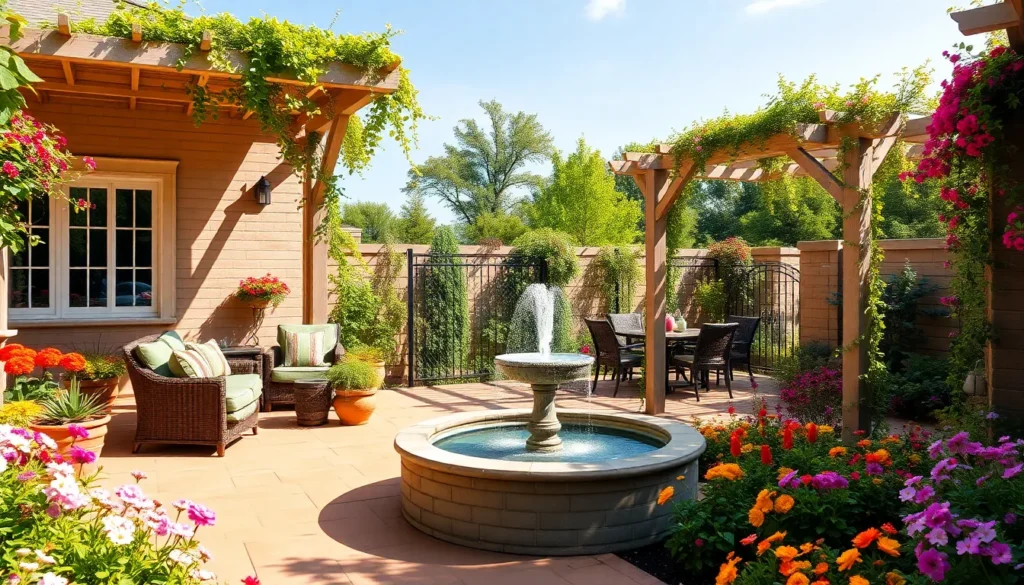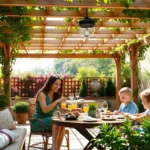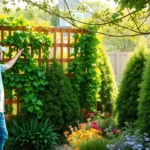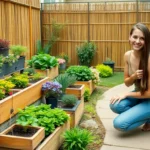Transform your outdoor space into a stunning sanctuary that reflects your personal style and enhances your home’s value. Whether you’re working with a sprawling backyard or a cozy urban plot we’ll help you discover landscaping ideas that turn your garden dreams into reality.
From budget-friendly DIY projects to luxurious outdoor retreats there’s a perfect landscaping solution waiting for every homeowner. We’ve gathered innovative design concepts that maximize curb appeal while creating functional spaces for relaxation and entertainment.
Ready to create an outdoor paradise that’ll make your neighbors envious? Let’s explore creative landscaping ideas that combine beauty practicality and sustainability to give you the garden you’ve always wanted.
Create a Focal Point With Statement Features
Statement features serve as the centerpiece of your garden design, drawing the eye and creating memorable experiences. We’ll explore three powerful ways to establish dramatic focal points that elevate your industry from ordinary to extraordinary.
Install a Water Feature or Fountain
Water features transform gardens into tranquil retreats while adding movement and sound to your outdoor space. Installing a fountain creates an immediate focal point that attracts birds and provides soothing background noise. Bubbling fountains work well in smaller gardens, while tiered water features suit larger landscapes with multiple viewing angles.
Wall-mounted spouts offer space-saving answers for compact areas and create elegant backdrops for seating areas. Pond installations with recirculating pumps provide habitats for aquatic plants and fish while serving as natural gathering spots. Solar-powered fountains eliminate electrical concerns and reduce ongoing operating costs.
We recommend positioning water features where they’re visible from multiple vantage points, including windows and outdoor seating areas. Natural stone surrounds blend seamlessly with existing hardscaping, while contemporary metal designs complement modern architectural styles.
Add a Sculptural Element or Garden Art
Sculptural elements inject personality into garden spaces and reflect your individual style preferences. Large statement sculptures anchor planting beds and provide year-round visual interest when perennials die back. Abstract metal pieces catch sunlight and create interesting shadows throughout the day.
Garden art collections tell stories through carefully curated pieces that complement your home’s architectural character. Weatherproof materials like bronze, stainless steel, and treated stone withstand seasonal changes without requiring extensive maintenance. Colorful ceramic installations brighten shaded areas and coordinate with flowering plants.
Strategic placement amplifies sculptural impact by positioning pieces at pathway intersections or garden room entrances. We suggest varying heights and textures to create ever-changing visual compositions that guide visitors through your industry design.
Design a Fire Pit or Outdoor Fireplace Area
Fire features extend outdoor living seasons and create natural gathering spaces for family entertainment. Built-in fire pits using natural stone or brick integrate seamlessly with existing hardscaping materials. Portable fire bowls offer flexibility for rearranging seating configurations based on group sizes and weather conditions.
Outdoor fireplaces provide wind protection and radiate heat more effectively than open fire pits. Gas-powered units offer convenient ignition and consistent flame control without ash cleanup requirements. Wood-burning options create authentic campfire experiences with crackling sounds and natural aromas.
Safety considerations include maintaining proper clearances from structures and overhanging vegetation. We recommend installing gravel or stone surfaces around fire features to prevent ember damage to lawn areas. Comfortable seating arrangements positioned 6-8 feet from flames optimize warmth while ensuring guest safety.
Design Structured Garden Beds and Borders
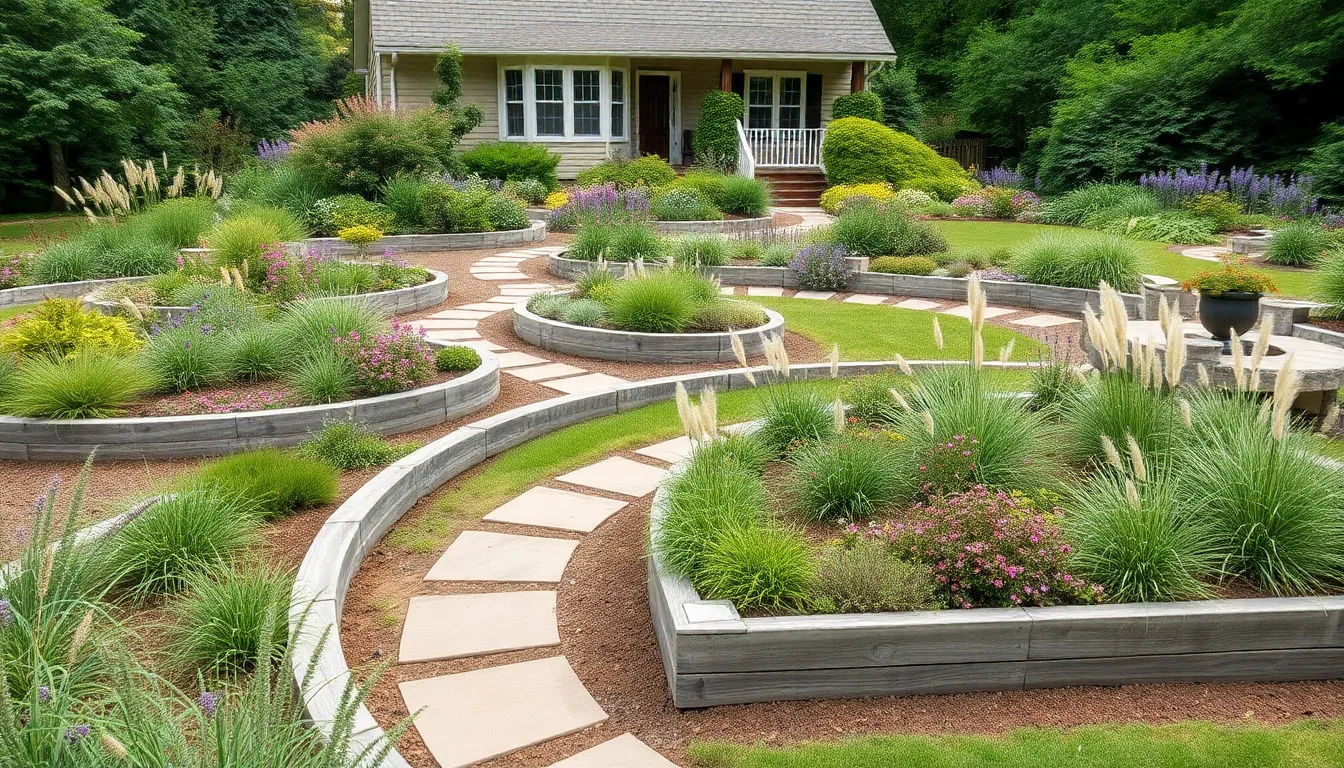
Well-defined borders and organized garden beds create the foundation for exceptional industry design. These structured elements provide framework that guides the eye and establishes visual harmony throughout your outdoor space.
Plan Geometric Flower Beds
Sculptural gravel gardens offer low maintenance answers with high visual impact. Choose shapes like circles, squares, or rectangles to create defined spaces that complement your home’s architecture. Add interest with strategically placed rocks, boulders, or sculptures that serve as focal points within each geometric section.
Symmetrical patterns bring order and sophistication to flower bed arrangements. Select plants that complement the geometric design while ensuring a visually cohesive layout across your industry. Consider using ornamental grasses or structured shrubs to maintain clean lines year round.
Modern minimalist fixtures enhance geometric garden designs through careful material selection. Incorporate rocks, gravel, and concrete elements to create contrast against plant textures. Arrange plants in symmetrical patterns that reinforce the structured aesthetic while maintaining seasonal interest.
Create Curved and Flowing Border Lines
Curved paths transform rigid landscapes into inviting spaces that encourage exploration. Use natural materials like stone or brick to create winding pathways that flow through different garden areas. These organic routes add visual interest while softening harsh architectural lines throughout your property.
Organic shapes provide gentle contrast to structured elements in your industry design. Incorporate rounded flower beds or borders that create softer, more natural transitions between different garden zones. This approach balances geometric elements with flowing forms that feel harmonious and welcoming.
Natural material integration enhances curved border effectiveness through thoughtful selection. Choose materials that complement your home’s exterior while providing durability for high traffic areas. Stone and brick options offer longevity while maintaining the organic aesthetic you’re creating.
Establish Raised Garden Beds
Materials variety gives you flexibility in creating raised beds that match your design vision. Use wood, stone, or concrete blocks to construct beds in various shapes and sizes that complement your industry style. Each material offers different aesthetic qualities and maintenance requirements to consider.
Functional use makes raised beds ideal investments for growing vegetables, herbs, or flowers in organized spaces. These elevated growing areas provide better drainage and soil control while adding practicality to your garden design. Consider accessibility when planning bed heights and widths for comfortable maintenance.
Aesthetic appeal transforms functional raised beds into attractive industry features through thoughtful design. These structures add texture and dimension to outdoor spaces while improving the overall visual impact of your garden. Strategic placement creates natural divisions between different industry zones while maintaining visual flow.
Incorporate Vertical Elements for Height and Interest
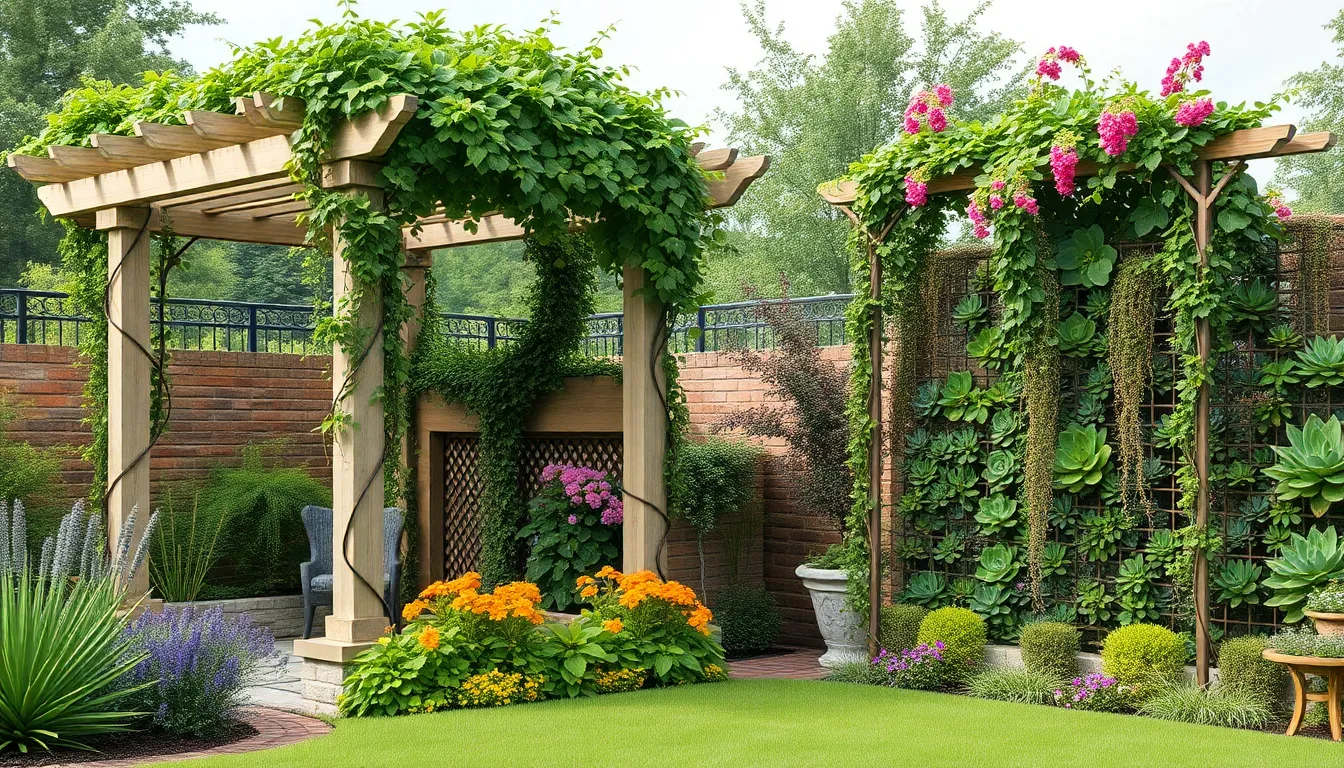
Adding vertical elements transforms flat garden spaces into ever-changing landscapes that maximize both visual appeal and growing area.
Install Trellises and Arbors
Trellises offer exceptional support for climbing plants while introducing architectural height to garden layouts. These versatile structures can define exact areas within your industry, creating distinct garden rooms or serving as stunning focal points that draw the eye upward. We recommend positioning trellises against fences or walls to maximize space efficiency while providing sturdy climbing surfaces.
Arbors create dramatic entrances and transitions between different garden zones. Installing these gateway structures over pathways or at garden borders establishes clear definition and adds instant sophistication to your outdoor space. Popular materials include cedar, vinyl, and powder-coated metal, each offering different aesthetic appeals and maintenance requirements.
Strategic placement of these structures enhances both functionality and beauty in your industry design. Consider installing multiple trellises at varying heights to create layered visual interest, or use arbors to frame exact views within your garden for maximum impact.
Plant Climbing Vines and Wall Gardens
Climbing vines naturally ascend trellises and arbors, adding lushness and seasonal color to vertical structures. Clematis, ivy, and climbing roses are particularly effective choices that provide year-round interest through varying bloom times and foliage textures. These plants can quickly transform bare vertical surfaces into living walls of greenery.
Wall gardens and living walls represent popular answers for maximizing vertical growing space. Modular panels attached to walls can house succulents, perennials, and ferns, creating dramatic green facades that soften hard surfaces throughout your industry. This approach works especially well for urban gardens with limited ground space.
Window boxes and macrame planters boost vertical interest by displaying flowers or foliage at eye level. These elevated plantings create immediate visual impact while keeping delicate plants away from ground-level pests and foot traffic. Strategic placement at different heights adds depth and dimension to vertical garden displays.
Add Pergolas and Garden Structures
Pergolas provide architectural interest and shade while supporting vigorous plant growth throughout the growing season. These overhead structures can be trained with vines to create living roofs, offering both beauty and cooling effects during warmer months. Popular vine choices include grape, wisteria, and jasmine for their rapid growth and attractive coverage.
Garden structures like gazebos and slatted wooden panels act as privacy screens while transforming open spaces into secluded retreats. These elements provide immediate structure to new gardens and can define outdoor rooms for different activities such as dining, relaxation, or entertaining guests.
Espaliered trees and shrubs represent another effective vertical technique where plants are trained flat against walls or fences. This method works particularly well for fruit trees and decorative shrubs, helping define property lines or garden boundaries while maximizing growing space in compact areas. Multi-tier raised beds and container stacks add additional vertical layers, allowing for diverse plant arrangements and microclimates within your garden space.
Choose Plants That Provide Year-Round Appeal
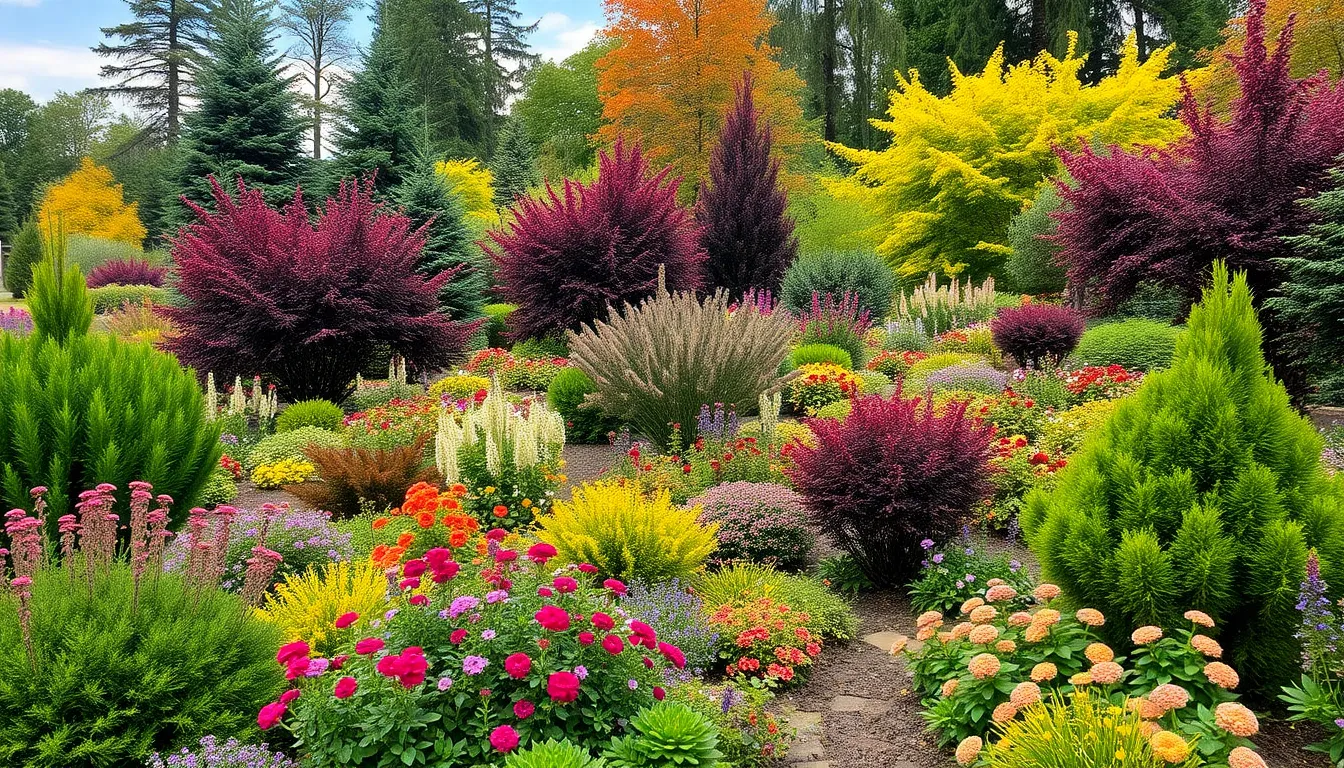
Building on our structural garden elements, we’ll now focus on plant selection that maintains visual interest throughout all seasons. Creating a vibrant garden requires strategic plant combinations that deliver continuous appeal.
Select Evergreen Trees and Shrubs
Evergreen trees form the backbone of year-round garden appeal by providing consistent structure when other plants go dormant. We recommend positioning these as backdrops for seasonal displays, creating depth and permanence in your industry. Popular choices include blue spruce, pine varieties, and cedar trees that maintain their foliage regardless of weather conditions.
Evergreen shrubs offer versatile answers for borders, hedges, and foundation plantings that never lose their visual impact. Boxwood creates excellent formal hedges, while rhododendrons provide both evergreen foliage and spectacular spring blooms. Japanese yews work perfectly for foundation plantings, and holly bushes add texture with their glossy leaves and colorful berries.
Consider the mature size of evergreen selections to avoid overcrowding issues later. Dwarf varieties like compact blue spruce or small-leafed boxwood work well in limited spaces without overwhelming other garden elements.
Plan for Seasonal Color Transitions
Spring color begins with early bloomers like tulips and daffodils that emerge when winter finally retreats. We suggest planting these bulbs in clusters for maximum visual impact, combining different varieties for extended bloom periods. Irises follow shortly after, providing elegant vertical lines and diverse color options.
Summer brings the peak growing season with hydrangeas delivering bold, long-lasting blooms in multiple colors. Agapanthus creates stunning blue and white flower clusters that thrive in warm weather, while day lilies offer continuous blooms throughout the hottest months. These warm-season bloomers maintain garden interest when spring flowers fade.
Fall extends garden beauty with asters providing purple, pink, and white daisy-like flowers that attract beneficial insects. Sedum varieties offer succulent foliage that transforms into bronze and red tones, while their flower heads remain attractive even after blooming ends. Late-blooming mums add traditional autumn colors in yellow, orange, and burgundy shades.
Winter interest comes from plants like Kniphofia that bloom in cooler months, plus ornamental grasses and perennials with attractive seed heads. These elements provide texture and movement during dormant seasons when other plants rest.
Include Native Plants for Low Maintenance
Native plants adapt naturally to local soil and climate conditions, requiring significantly less water, fertilizer, and pest control than non-native alternatives. We emphasize native selections because they support local ecosystems while reducing maintenance demands on busy homeowners.
Coneflowers (Echinacea) provide stunning purple, pink, and white blooms that attract butterflies and beneficial insects throughout summer. Black-eyed Susans deliver bright yellow flowers from midsummer through fall, creating cheerful displays that self-seed for future years. These hardy perennials return reliably each season without replanting.
Native grasses add texture and movement while requiring minimal care once established. Little bluestem grass provides blue-green summer foliage that turns bronze in autumn, while switchgrass creates tall, airy displays perfect for privacy screens. Prairie dropseed forms neat clumps with delicate flower heads that catch morning dew beautifully.
Research your exact region’s native plant options through local extension offices or native plant societies for the best results. These resources provide detailed information about which species thrive in your particular climate zone and soil conditions.
Establish Functional Pathways and Walkways
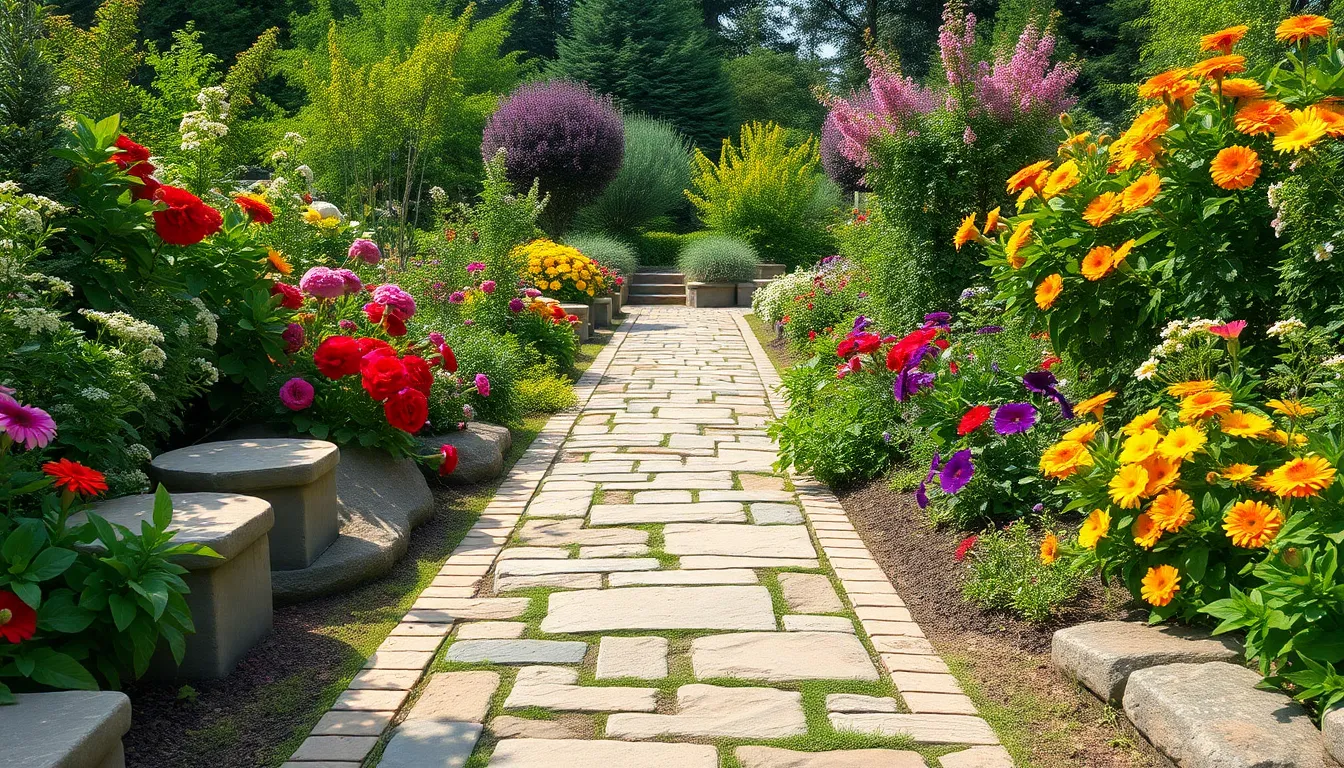
Well-designed pathways transform your garden from a collection of scattered elements into a cohesive outdoor experience. These functional routes guide visitors through your industry while connecting different garden areas seamlessly.
Design Stone or Brick Walkways
Stone and brick walkways offer unmatched durability and timeless aesthetic appeal for your garden paths. We recommend these materials because they withstand weather conditions while maintaining their visual impact year after year.
Pattern variety lets you customize the walkway’s appearance to match your garden’s style. Herringbone patterns work beautifully in formal settings, while random stone layouts complement cottage garden designs perfectly.
Edging installation defines your pathway boundaries and prevents material spillage over time. Metal edging provides clean lines for modern gardens, plastic offers budget-friendly functionality, and stone or brick edging creates seamless transitions between path and planting areas.
Maintenance requirements remain minimal with proper installation and quality materials. Regular sweeping removes debris, while occasional joint sand replacement keeps stones stable and level.
Create Gravel or Mulch Paths
Gravel paths deliver rustic charm while staying budget-friendly for most landscaping projects. The satisfying crunching sound adds sensory appeal as visitors walk through your garden spaces.
Cost effectiveness makes gravel an excellent choice for extensive pathway networks. You’ll spend significantly less compared to stone or brick installations while achieving professional-looking results.
Mulch paths blend naturally into garden surroundings using organic materials like shredded bark or wood chips. These paths help retain soil moisture and suppress weed growth along walkway edges.
Installation simplicity allows weekend DIY completion for most gravel and mulch pathway projects. Basic excavation, industry fabric placement, and material spreading create durable walking surfaces.
Install Stepping Stone Routes
Natural stone stepping stones create visually appealing paths that guide visitors through garden areas with adventure and exploration. Various shapes and sizes offer design flexibility for unique pathway configurations.
Concrete alternatives provide budget-conscious options while maintaining stepping stone functionality. Pre-cast concrete stones come in multiple colors and textures to complement your garden’s aesthetic.
Pattern placement influences your pathway’s visual impact and walking experience. Random placement creates organic, naturalistic routes, while geometric patterns suit formal garden designs better.
Safety considerations require proper spacing between stones for comfortable walking strides. We recommend 18 to 24-inch spacing between stone centers for adult pedestrians, with closer spacing for children’s areas.
Add Outdoor Living and Entertainment Spaces
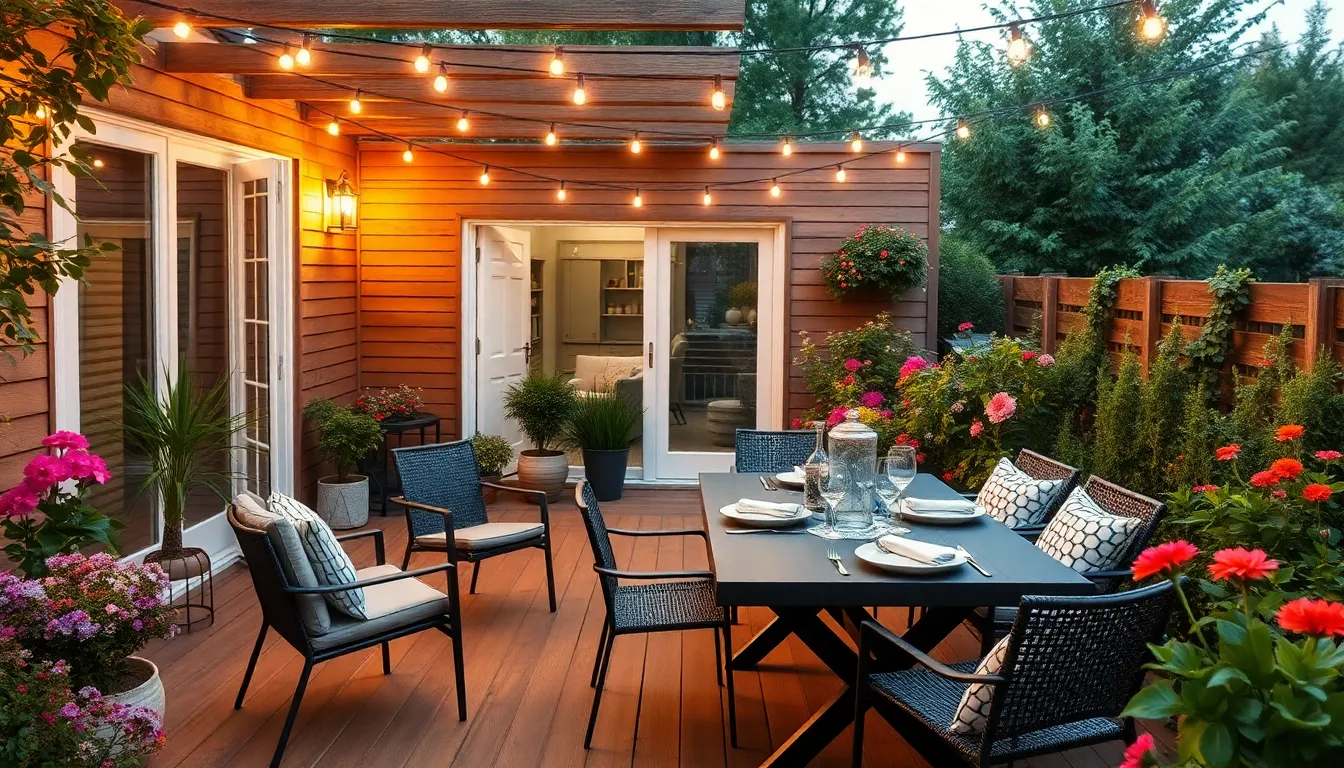
Transforming your garden into a multifunctional outdoor retreat creates opportunities for relaxation and entertainment while increasing your home’s value. We’ll explore essential elements that combine functionality with aesthetic appeal to design inviting spaces for every occasion.
Create a Patio or Deck Area
Establish your outdoor foundation with a well-designed patio or deck that serves as the central hub for all garden activities. Materials like wood, stone, or composite decking offer distinct advantages based on your climate and maintenance preferences.
Position your patio strategically to maximize both morning sun and afternoon shade, creating comfortable conditions throughout the day. We recommend choosing composite decking for its durability and low maintenance requirements, especially in areas with harsh weather conditions.
Integrate outdoor furniture that complements your chosen materials while providing comfortable seating for various group sizes. Add string lights or lanterns to extend usability into evening hours and create a warm, inviting atmosphere.
Consider drainage requirements during installation to prevent water pooling and ensure your patio remains functional during all seasons. Proper grading and permeable materials help maintain structural integrity while protecting your investment.
Design an Outdoor Dining Zone
Designate a exact dining area that incorporates essential cooking and serving elements for seamless outdoor meal preparation. Built-in grills, prep counters, and storage answers create a functional outdoor kitchen that rivals indoor facilities.
Install adequate lighting around your dining zone to ensure safety and ambiance during evening gatherings. We suggest combining task lighting for food preparation with ambient lighting for dining comfort.
Select weather-resistant furniture that can withstand your local climate while providing comfortable seating for family and guests. Materials like teak, aluminum, or all-weather wicker offer durability without sacrificing style.
Create defined boundaries using planters, screens, or pergolas to separate your dining area from other garden zones. This separation helps establish intimate dining experiences while maintaining visual connection to your broader industry.
Establish a Garden Seating Area
Incorporate various seating options throughout your garden to create multiple relaxation zones that serve different purposes and group sizes. Benches provide permanent seating along pathways, while hammocks offer casual lounging opportunities.
Position seating strategically among lush greenery to create secluded spots that encourage contemplation and connection with nature. We recommend placing chairs or benches near fragrant plants or water features to enhance the sensory experience.
Add lounge chairs in areas that receive optimal sun exposure for reading or sunbathing during pleasant weather. Consider adjustable options that allow users to customize their comfort level throughout the day.
Install weatherproof cushions and accessories to maintain comfort while protecting your investment from outdoor elements. Storage benches provide both seating and practical answers for cushion storage during inclement weather.
Implement Creative Lighting Solutions
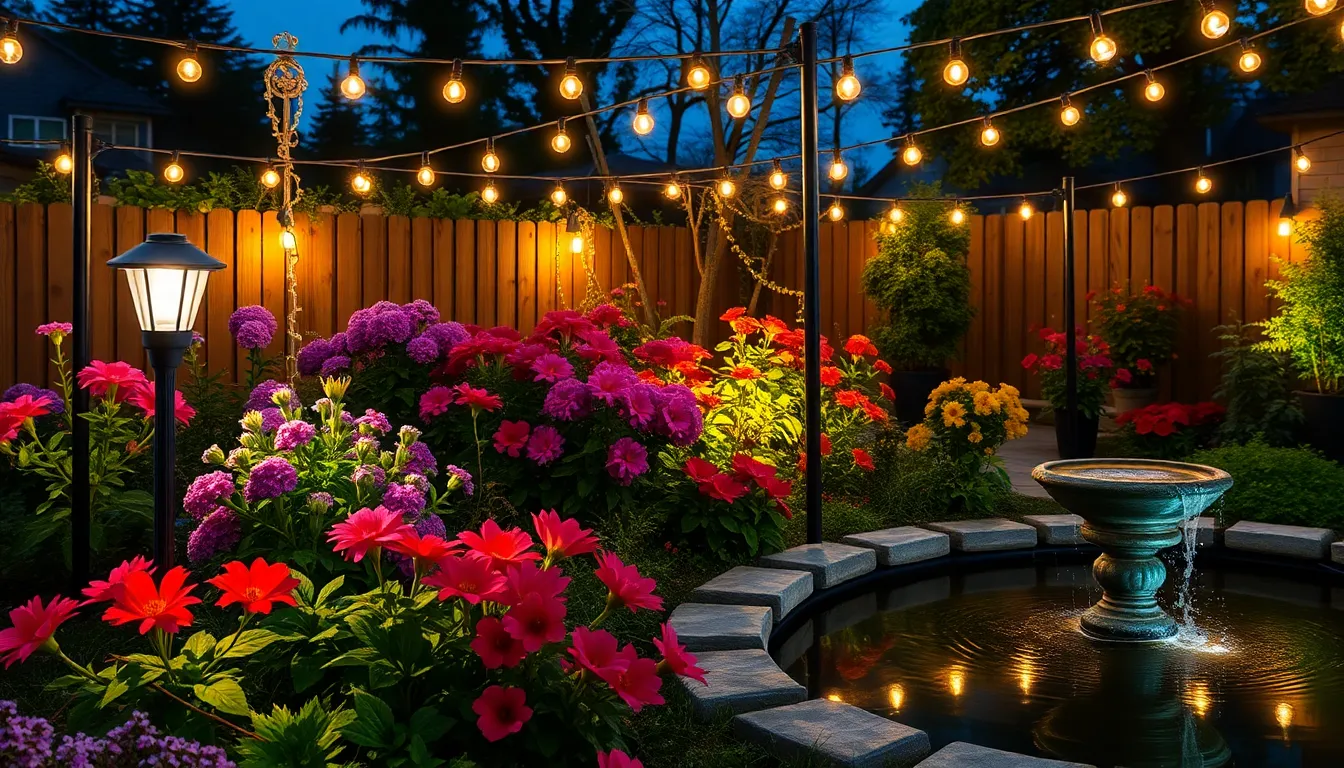
Proper lighting transforms your garden from a daytime showcase into an enchanting nighttime retreat. Strategic illumination extends your outdoor living hours while creating dramatic visual effects that enhance your industry’s natural beauty.
Install Solar-Powered Garden Lights
Solar powered garden lights offer an eco friendly and cost effective way to illuminate your outdoor space without increasing electricity bills. These energy efficient fixtures automatically charge during daylight hours and provide gentle illumination throughout the evening.
Path lighting creates safe navigation routes while highlighting garden borders and walkway edges. Position solar stake lights every 6 to 8 feet along walkways to ensure consistent coverage without overwhelming the natural industry. Garden bed spotlights can showcase exact plantings like your prize hydrangeas or architectural evergreens.
We recommend choosing LED solar lights with higher lumens ratings for brighter output and longer battery life. Weather resistant models withstand seasonal changes while requiring minimal maintenance beyond occasional cleaning of solar panels.
Add String Lights and Lanterns
String lights create whimsical ambiance that transforms ordinary garden spaces into magical outdoor rooms. Drape cafe style bulbs between pergola posts or wrap them around mature tree trunks to establish warm gathering areas. Edison bulb strings provide vintage charm while LED options offer energy efficiency and longer lifespan.
Lanterns add elegant focal points that complement various garden styles from rustic farmhouse to modern minimalist designs. Solar lanterns eliminate wiring concerns and can be relocated seasonally to highlight different areas. Paper lanterns work beautifully for special occasions while metal or glass versions provide permanent decorative elements.
Combine multiple light sources at different heights to create layered illumination throughout your outdoor entertainment zones. String lights overhead paired with lanterns on tables or hanging from shepherd hooks establish inviting conversation areas.
Use Spotlights for Accent Lighting
Spotlights deliver focused illumination that highlights your garden’s most impressive features and creates dramatic visual depth. Position LED spotlights at the base of specimen trees to cast intriguing shadows and emphasize architectural branching patterns. Water features like fountains or ponds become mesmerizing focal points when properly lit from below or at angles.
Sculpture and garden art require careful spotlight placement to avoid harsh shadows while showcasing artistic details. Adjust beam angles to create the desired effect whether you’re illuminating a climbing rose on a trellis or emphasizing the texture of natural stone walls.
Low voltage spotlight systems provide flexibility for future adjustments while ensuring safe installation around water elements. Timer controls and motion sensors add convenience while reducing energy consumption during inactive hours.
Design Themed Garden Sections
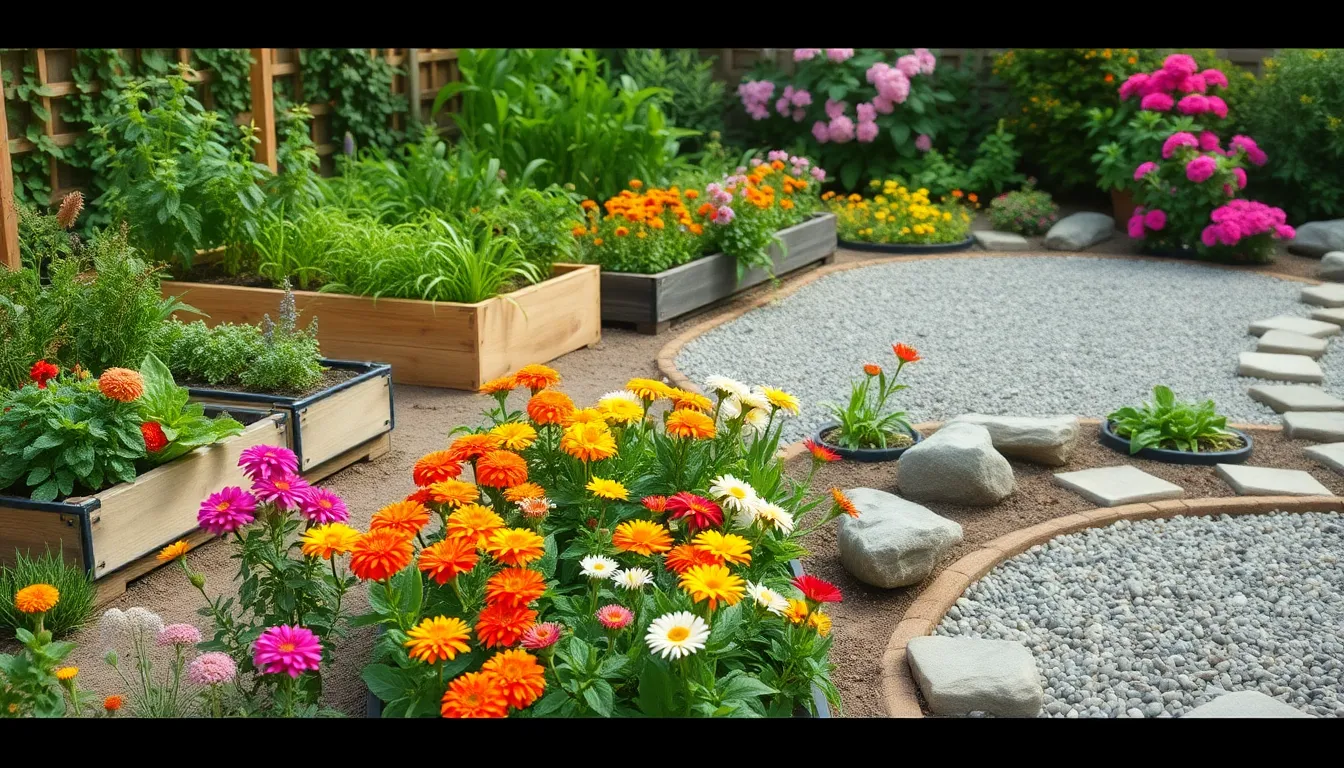
We can transform our outdoor spaces into captivating environments by creating distinct themed areas that reflect our personal interests and serve exact purposes. Each themed section adds character while maximizing both beauty and functionality throughout our garden industry.
Create a Herb and Vegetable Garden
Growing edible plants in dedicated spaces brings both practicality and visual appeal to our landscaping design. We’ll want to install raised beds or vertical gardening systems that accommodate herbs like basil, mint, thyme, and sage alongside vegetables suited to our local climate. Positioning these edible gardens close to our kitchen ensures easy access for daily cooking needs.
Companion planting techniques help us improve plant growth while naturally reducing pest problems without harmful chemicals. Native plants mixed with our edible selections create visual interest and support local ecosystems. We can maximize limited space by implementing vertical growing systems that use walls and fences for climbing varieties.
Establish a Butterfly or Pollinator Garden
Attracting beneficial insects transforms our garden into a thriving network that supports local wildlife populations. We need to plant native flowering species alongside milkweed for monarch butterflies and include shrubs that provide essential shelter for various pollinators. Avoiding pesticides entirely protects these delicate creatures and maintains the natural balance we’re working to create.
Grouping similar plant varieties together makes pollination easier and more efficient for visiting insects. Native options like coneflowers and black-eyed Susans offer both beauty and resilience while requiring minimal maintenance. We should include shallow water sources throughout the space to support butterfly and bee populations during dry periods.
Design a Zen or Meditation Garden
Creating peaceful, minimalist spaces for relaxation requires careful attention to simplicity and tranquility. We can use sand or gravel for raked patterns alongside smooth stones and select evergreen shrubs that maintain year-round structure. Simple water features add gentle sounds without overwhelming the serene atmosphere we’re cultivating.
Keeping our design uncluttered helps maintain the meditative quality essential to these spaces. Low maintenance plants and subtle lighting extend the usability of our zen garden into evening hours. We should focus on textures and forms rather than bold colors to preserve the calming effect that makes these gardens so valuable for stress relief.
Incorporate Sustainable and Eco-Friendly Features
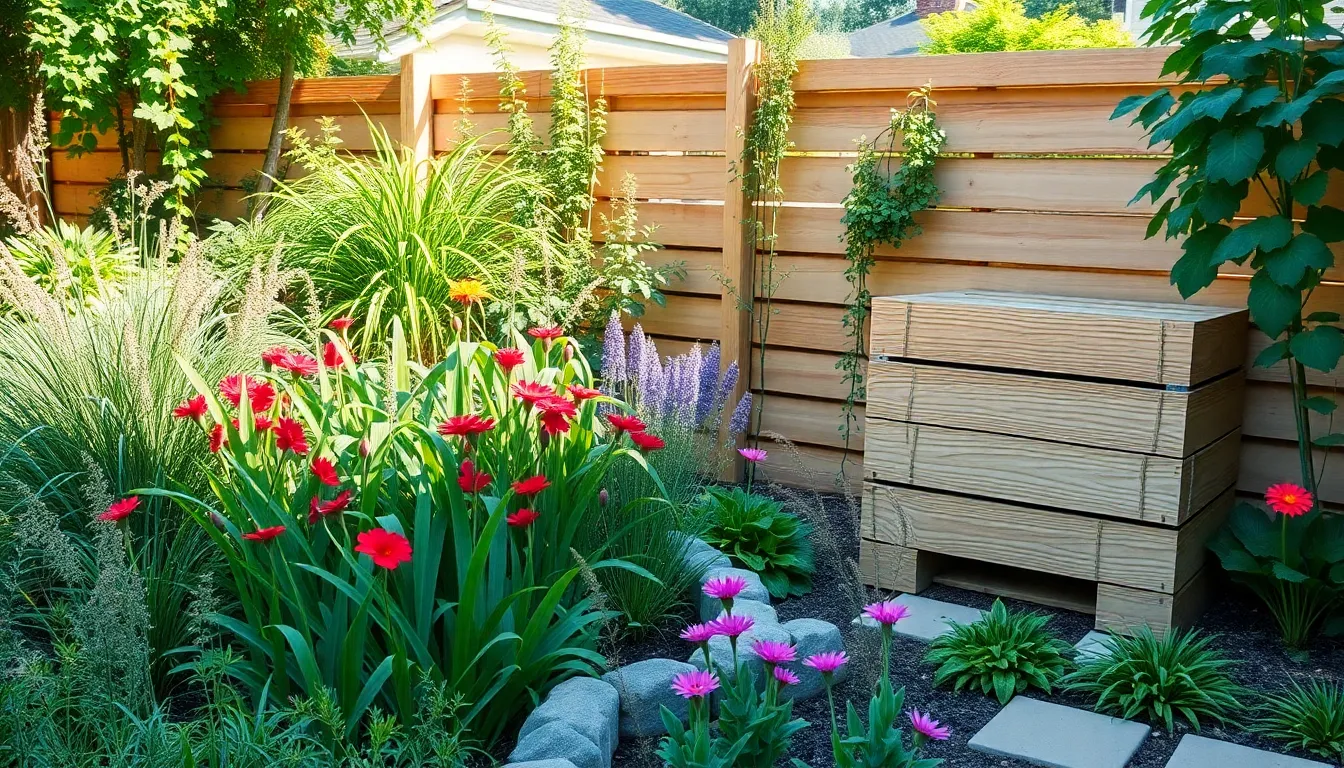
We can create stunning gardens while protecting our environment through thoughtful design choices that benefit both our landscapes and local ecosystems. Smart sustainable practices reduce maintenance costs and conserve precious natural resources.
Install Rain Gardens and Bioswales
Rain gardens transform problematic drainage areas into beautiful industry features that naturally filter stormwater runoff. These shallow depressions collect rainwater during storms and slowly release it into the ground, preventing erosion and reducing pollution in nearby waterways. Position rain gardens in low-lying areas where water naturally flows, incorporating native plants like sedges, cardinal flower, and blue flag iris that thrive in wet conditions.
Bioswales offer similar benefits while adding sophisticated design elements through strategic use of berms and swales. Install these vegetated channels along driveways or property edges to capture and filter runoff before it reaches storm drains. Choose plants with deep root systems such as switchgrass and New England aster to maximize water absorption and soil stabilization.
Create Composting Areas
Composting areas turn kitchen scraps and yard waste into nutrient-rich soil amendments that feed our gardens naturally. Designate a corner of your industry for a three-bin composting system that allows continuous decomposition cycles throughout the year. Layer brown materials like dried leaves and paper with green materials such as vegetable scraps and grass clippings to maintain proper carbon-to-nitrogen ratios.
Build attractive composting structures using cedar boards or recycled plastic lumber that blend seamlessly with your garden design. Position compost bins away from main entertainment areas but within easy reach of both kitchen and garden beds for convenient use. Screen composting areas with tall ornamental grasses or evergreen shrubs to maintain visual appeal while supporting sustainable gardening practices.
Use Drought-Resistant Landscaping
Drought-resistant plants eliminate the need for frequent watering while creating striking visual displays that thrive in challenging conditions. Native species like purple coneflower, black-eyed Susan, and little bluestem naturally adapt to local rainfall patterns and require minimal supplemental irrigation once established. Group plants with similar water needs together to maximize efficiency and reduce maintenance requirements.
Replace traditional grass lawns with drought-tolerant ground covers such as creeping thyme, buffalo grass, or native sedums that provide year-round interest with minimal water input. Apply organic mulch around plantings to retain soil moisture, regulate temperature, and suppress weeds while slowly decomposing to add valuable nutrients to the soil. Choose permeable paving materials like natural stone or permeable pavers instead of concrete to allow rainwater absorption and reduce surface runoff.
Conclusion
We’ve explored countless ways to transform your outdoor space into a stunning industry that reflects your unique style and meets your family’s needs. From budget-friendly DIY projects to luxurious design elements these ideas offer something for every homeowner looking to enhance their property’s appeal.
The key to successful landscaping lies in thoughtful planning that balances beauty functionality and sustainability. Whether you’re drawn to modern geometric designs or prefer natural flowing curves the possibilities are truly endless when you combine creativity with practical considerations.
Remember that the best gardens evolve over time so don’t feel pressured to carry out every idea at once. Start with one or two elements that excite you most and gradually build upon your outdoor sanctuary as your vision develops and your budget allows.
Frequently Asked Questions
What are some budget-friendly landscaping ideas for beginners?
Start with DIY projects like creating gravel paths, installing raised garden beds, and planting native species. Use mulch to define areas and add visual appeal. Consider container gardening and solar-powered lighting for immediate impact. Focus on low-maintenance plants and repurpose materials when possible to keep costs down while creating beautiful outdoor spaces.
How can I create focal points in my garden design?
Install water features like bubbling fountains or tiered installations to add movement and tranquility. Incorporate sculptural elements or garden art using weatherproof materials. Design fire pits or outdoor fireplaces for gathering spaces. Strategic placement and proper scale are key to creating impactful focal points that draw attention and enhance your garden’s visual appeal.
What are the benefits of raised garden beds?
Raised garden beds improve drainage and soil control while adding texture and dimension to your landscape. They provide better accessibility for planting and maintenance, reduce back strain, and allow for better soil management. These functional features also serve as attractive design elements that enhance the overall aesthetic of your outdoor space.
How do I incorporate vertical elements in small gardens?
Install trellises and arbors to support climbing plants and create architectural height. Use wall gardens and climbing vines to transform vertical surfaces into living walls. Add window boxes and macrame planters for visual interest. Consider pergolas for shade and structure, or try espaliering trees and shrubs to maximize growing space efficiently.
What plants provide year-round visual interest?
Choose evergreen trees and shrubs like blue spruce and boxwood for consistent structure. Plan seasonal transitions with spring bloomers (tulips), summer favorites (hydrangeas), and fall staples (asters). Include native plants like coneflowers and black-eyed Susans for low maintenance. Native grasses add texture and movement while requiring minimal care throughout the seasons.
How do I design functional outdoor pathways?
Use stone or brick walkways for durability and aesthetic appeal, incorporating various patterns to match your garden style. Install proper edging to define boundaries and prevent material spillage. Consider gravel and mulch paths as budget-friendly alternatives. Space stepping stones properly for safety, and ensure pathways connect key areas while guiding visitors through your landscape.
What should I consider when creating outdoor entertainment spaces?
Position patios or decks strategically for optimal sun and shade balance. Choose materials like wood, stone, or composite based on your climate and maintenance preferences. Include comfortable outdoor furniture and adequate lighting for evening use. Design outdoor dining zones with cooking elements and create multiple seating areas throughout the garden for varied experiences.
How can I use lighting to enhance my outdoor space?
Install solar-powered garden lights for eco-friendly path illumination and safety. Use string lights and lanterns to create whimsical ambiance. Add spotlights to highlight key garden features like trees or sculptures. Combine multiple light sources at different heights to achieve layered illumination that transforms your outdoor space into an enchanting nighttime retreat.
What are some popular themed garden ideas?
Create herb and vegetable gardens using raised beds or vertical systems with companion planting techniques. Design butterfly or pollinator gardens with native flowering species and shallow water sources. Establish Zen or meditation gardens focusing on simplicity with raked patterns, smooth stones, and low-maintenance plants for a calming retreat that promotes relaxation.
How can I make my landscaping more sustainable?
Install rain gardens and bioswales with native plants to manage stormwater runoff. Create composting areas to recycle kitchen scraps and yard waste into nutrient-rich soil. Use drought-resistant landscaping by replacing traditional lawns with drought-tolerant ground covers. Apply organic mulch to retain soil moisture and reduce water usage while supporting local ecosystems.

